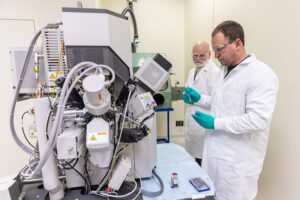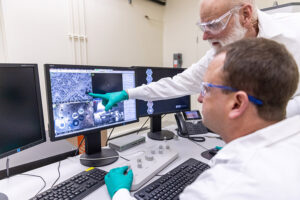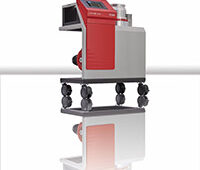From the University of Missouri
For more than half a century, the University of Missouri has been a leader in nuclear science and engineering research thanks to the MU Researcher Reactor (MURR), the highest-powered research reactor at any university in the country.

John Gahl (left) and Caleb Philipps, senior research scientists at the University of Missouri Research Reactor, prepare a sample to be loaded into the scanning electron microscope. Photo by Abbie Lankitus
Building on MURR’s internationally recognized level of excellence, the university is looking into the future by adding a scanning electron microscope (SEM) to the facility’s research equipment. This new tool can help researchers make discoveries in materials science. It also places MU on a small, prominent list of academic and government facilities, such as the Department of Energy’s Oak Ridge and Idaho National Laboratories, which have similar diagnostic tools for research purposes in radiation environments.
Scientists can use the SEM to characterize materials such as steel or nickel alloys after irradiation in MURR. This knowledge can help engineers select the optimal building materials when developing the next generation of commercial nuclear power plants across the United States. Since 1990, nuclear power plants have generated at least 20% of the total electrical energy used annually in the U.S. according to the U.S. Energy Information Administration.

Caleb Philipps and John Gahl (right), senior research scientists at the University of Missouri Research Reactor, examine an image taken from a sample being analyzed by the scanning electron microscope.
“In many different engineering fields, the limiting factor of performance often ends up being how materials respond to their environments,” said John Gahl, professor in the College of Engineering and senior research scientist at MURR. “Here, we’re helping build the knowledge base for materials that can be used in a nuclear energy environment by providing the information needed to make data-informed decisions.”
The SEM will also allow researchers to determine how a material responds in an environment where it’s exposed to radiation, such as inside a nuclear power plant.
“We can test reactor component materials in a macro way, such as on a load frame, and also characterize them on a micro level with the SEM,” said Gahl. “This allows us to examine the structure before and after irradiation, to look for changes in the material’s structure and to determine how materials performance may be affected.”
Gahl believes the technology will help generate new collaborations among researchers at MU and beyond.
showme.missouri.edu/schools-colleges/mu-college-of-engineering/





Tell Us What You Think!